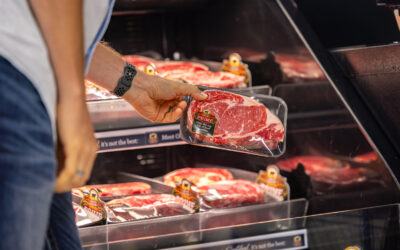
First-born beef advantage
by Wyatt Bechtel
Early-born calves have a better chance than the later born of making a profit for their owners.
That’s what a 2010 study of Iowa Tri-County Steer Carcass Futurity (TCSCF) data helped confirm. The analysis looked at birth date and age of Angus-Simmental rotational crossbred calves, compared to their feedlot performance and carcass traits.
Birth-to-harvest data on 1,369 spring-born calves from 2002 to 2007 on a central Missouri ranch were divided into four groups by date of birth.
Those born in the first 21 days qualified for the Certified Angus Beef ® (CAB®) brand 28.6% of the time compared to only 11.24% for the calves born after 63 days in the sequence. Calves in the mid-early (22 to 42 days) sequence went 24.37% CAB while those born 43 to 63 days managed only 16.28% qualifiers.
“I didn’t expect to see that large of a difference in quality,” says Darrell Busby, TCSCF manager. Carcasses from the early-born calves earned approximately $11 more than those from the two middle groups, while outperforming the late group by more than $40 (see table).
Busby was also surprised at how the later-born calves did not catch up to their earlier-born herd mates in terms of weight gain. The oldest calves each year had higher weights entering and leaving the feedlot compared to their younger counterparts.
“In other words, you are going to have higher quality grades and more pounds in the earliest born calves,” says Gary Fike, beef cattle specialist for CAB, who presented the findings at last year’s American Society of Animal Science meeting in Denver. The abstract and slide presentation may be viewed at https://cabcattle.com/news/research/index.php
Another somewhat surprising note from the research indicated the earlier a calf was born, the better its disposition. Busby found logic in that, however: “The more time you interact with cattle, the more it allows them to adapt to you. That’s probably why we saw more docile disposition scores in the earlier-born calves.”
The University of Nebraska pioneered this area of research with a study that looked at progeny of a Red Angus-Simmental herd at the Gudmundsen Sandhills Laboratory near Whitman, Neb., finished at the West Central Research and Extension Center near North Platte, Neb.
Nebraska animal scientist Rick Funston says the study, which aimed to underline the importance of a short calving period, showed 30% of calves born in the first 21 days of calving graded average Choice or higher. Fewer than 17% of later-born calves hit that mark.
Carcass weight was positively affected as calves were born earlier. There was a 45-pound (lb.) difference in final carcass weight between the earliest born calves and those born after 42 days.
It all added up to a $77 advantage in carcass value for the oldest calves, but there are other advantages, too. “Probably the biggest impact is that those cows that calve earlier are going to have a longer period in which to rebreed,” Funston notes, adding the resultant increase in cow longevity will decrease the need for replacement heifers as well.
The study also looked at the impact of heat synchronization on pasture mating, as one possible intervention method. Cows injected with prostaglandin five days after bull turn-in had more calves born in the first 21 days of the calving season and weaned heavier, more valuable calves. Both studies show the benefits of a more uniform calf crop.
“Extension and universities have been telling us for a long time to tighten up your calving season from the basis of marketing your calves and making them as uniform as possible,” Fike says.
When retaining ownership on feed, he recommends selling the latest born calves at weaning to help increase uniformity in the rest: “Let someone else manage those late calves as you reap the benefits of the older calves.”

You may also like
CAB Sets Sales Records, Sees Historically High Brand Acceptance Rates
In an otherwise tough time in the beef business, sales and supply records have been a bright spot. The positive numbers mean that quality beef production has not let up, and beef demand is holding. Consumers have proven the value proposition: the good stuff is worth a little more money, for a better eating experience.
Feeding Quality Forum Dates Set Earlier in August
When you’re feeding cattle, it counts to keep track of every calf, pound and dollar. Beyond the event’s educational sessions, networking between segments of the beef supply chain is invaluable—from feeders and cow-calf operators to allied industry and university researchers.
Gardiners Highlight Service, Strength at Foodservice Leaders Summit
Mark Gardiner and his son, Cole, of Gardiner Angus Ranch offered a boots-on-the-ground perspective for CAB specialists attending the annual event, designed to deliver resources that help train foodservice teams and serve consumers at a higher level.



